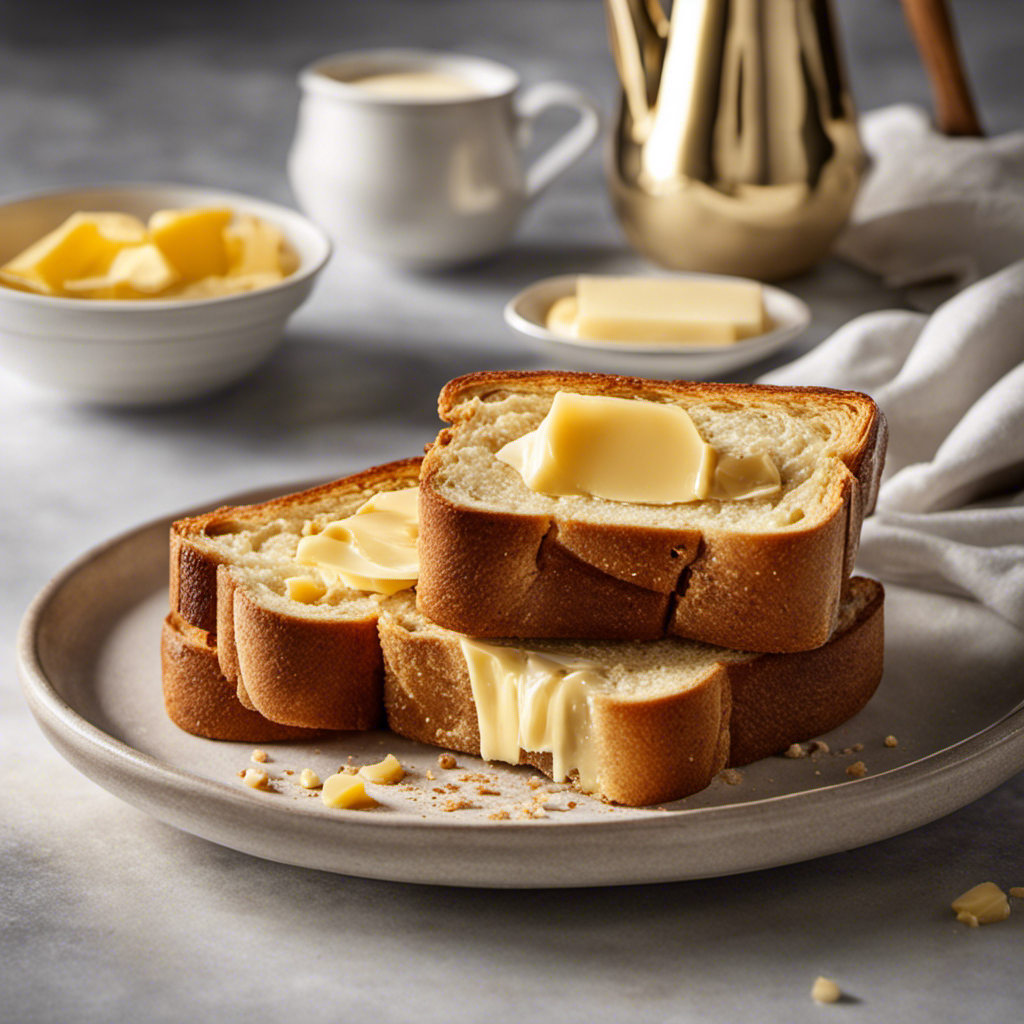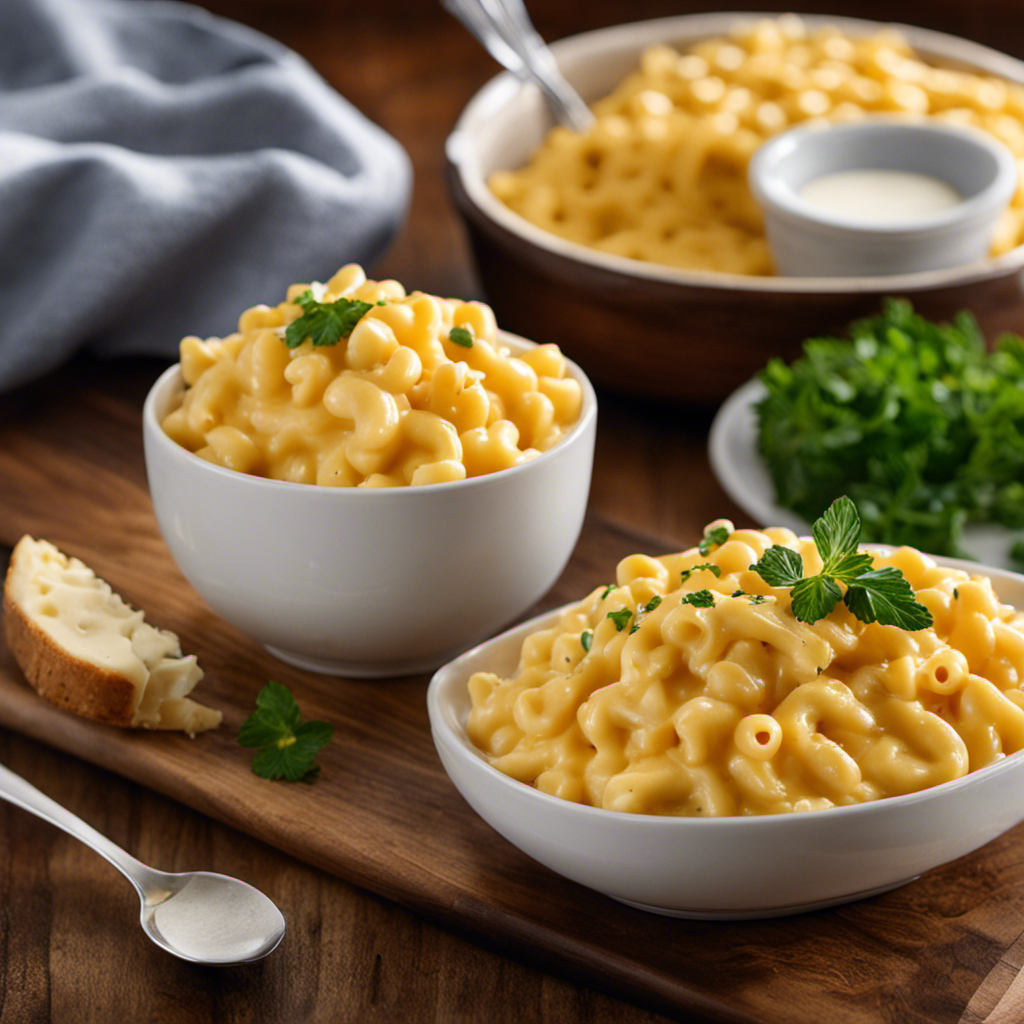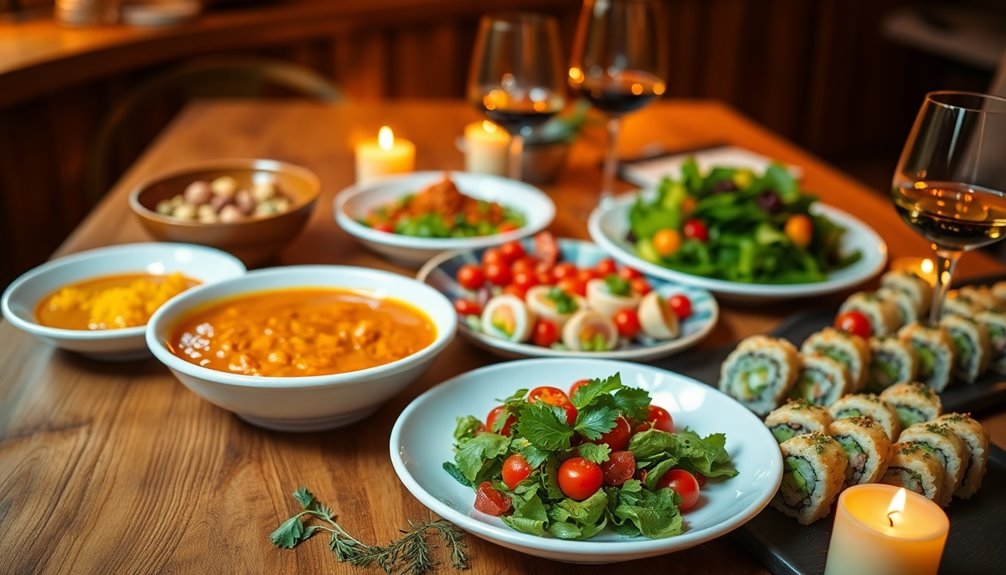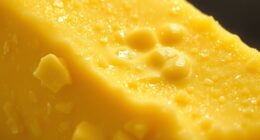Picture the luxurious, earthly scent of truffles blended into smooth, rich butter. That’s the enchantment of homemade truffle butter.
As a passionate food enthusiast, I can’t help but be captivated by the luxurious flavors and versatility of this culinary delight. In this article, I’ll guide you through the process of making your own truffle butter, from selecting the perfect truffles to expertly combining them with essential ingredients.
Get ready to elevate your cooking and indulge in a touch of gourmet decadence.
Key Takeaways
- Truffle butter is a luxurious spread made by combining butter with finely chopped truffles.
- Truffle butter adds a touch of decadence and richness to dishes.
- Truffle butter can be made using different types of truffles, each with its own unique flavor profile.
- Truffle butter should be stored in an airtight container in the refrigerator to preserve freshness and aroma.
What Is Truffle Butter
If you’re wondering what truffle butter is, it’s a luxurious spread made by combining butter with finely chopped truffles. The result is a creamy and flavorful concoction that elevates any dish it touches. Truffle butter adds a touch of decadence and richness to everything from pasta and risotto to grilled meats and vegetables. It’s like a little black diamond that transforms ordinary meals into gourmet experiences.
While truffle butter is undeniably delicious, there are alternatives for those who can’t get their hands on real truffles. Some recipes use truffle oil or truffle salt to achieve a similar flavor profile. These alternatives may not have the same depth and complexity as truffle butter, but they can still add a hint of truffle essence to your dishes.
In terms of health benefits, truffle butter should be enjoyed in moderation due to its high fat content. However, truffles themselves are known to have antioxidant properties and are rich in vitamins and minerals. They may also have potential anti-inflammatory effects. So, while truffle butter may not be the healthiest option, the truffles it contains can provide some nutritional benefits.
Choosing the Right Truffles
To choose the right truffles, you’ll want to look for ones that have a strong aroma and a firm texture. When it comes to truffle butter, using high-quality truffles is essential to get the best flavor and benefits.
There are different types of truffles, each with its own unique characteristics. The most sought-after truffle is the black truffle, known for its earthy and intense flavor. It pairs well with savory dishes like pasta and risotto.
Another popular variety is the white truffle, which has a more delicate and aromatic taste. It is often shaved over dishes like eggs or mashed potatoes to enhance their flavor.
Whichever truffle you choose, incorporating it into butter will elevate your dishes with its rich and decadent essence. Truffle butter adds a luxurious touch to everything from steaks to popcorn, making it a versatile and indulgent ingredient.
Essential Ingredients for Truffle Butter
When choosing ingredients for truffle butter, it’s important to select high-quality butter and aromatic seasonings. Truffle butter is all about elevating your dishes with the rich and earthy flavor of truffles.
The first step is choosing the right truffles. There are various types available, such as black truffles, white truffles, and even summer truffles. Each has its own unique flavor profile, so it’s important to pick one that suits your taste. Personally, I prefer the intense and pungent aroma of black truffles.
However, if you can’t get your hands on fresh truffles, don’t worry. There are truffle butter alternatives available, such as truffle oil or truffle salt, that can still give your dishes that luxurious truffle taste.
Tools and Equipment Needed
When it comes to cooking, having the right tools and equipment can make all the difference. In my opinion, there are a few essential kitchen utensils that every home cook should have.
From a sharp chef’s knife to a versatile spatula, these tools will help you tackle any recipe with confidence.
And if you’re planning on making truffle butter, there are a few must-have cooking tools and equipment that will ensure you achieve the perfect balance of flavors and textures.
Essential Kitchen Utensils
You’ll need a few essential kitchen utensils for making truffle butter. Trust me, these tools will make your truffle butter-making experience so much easier and enjoyable.
Here are my top picks for must-have kitchen gadgets when it comes to making this decadent spread:
-
A high-quality truffle slicer: This tool allows you to slice the truffles into thin, delicate pieces, ensuring that their flavor is evenly distributed throughout the butter.
-
A sturdy wooden spoon: When mixing the truffle slices into the softened butter, a wooden spoon provides the perfect balance of control and durability.
-
A silicone spatula: Once the truffle butter is ready, a silicone spatula is ideal for scraping every last bit out of the bowl, ensuring that none of that precious truffle goodness goes to waste.
Now that you have the essential kitchen utensils covered, let’s move on to the must-have cooking tools for making truffle butter even more effortlessly.
Must-Have Cooking Tools
Now that we know which kitchen utensils are essential, let’s talk about how to maintain them and choose the right ones for your cooking needs.
When it comes to keeping your cooking tools in good condition, there are a few tips to remember. Firstly, always clean them thoroughly after each use, using warm soapy water and a soft sponge. Avoid using abrasive cleaners that can damage the surface.
Secondly, store them properly, whether it’s hanging them up on a rack or placing them in a drawer with dividers to prevent them from scratching against each other.
Now, when it comes to choosing the right kitchen utensils, consider the material, functionality, and durability. Stainless steel utensils are a great option as they are resistant to rust and stains. Look for utensils with ergonomic handles for a comfortable grip.
Ultimately, investing in high-quality cooking tools will make your kitchen experience much more enjoyable and efficient.
Equipment for Truffle Butter
To get the best flavor and texture, it’s important to use high-quality ingredients in your truffle butter recipe. Truffle butter is a luxurious and versatile condiment that can elevate any dish.
Here are some key equipment you’ll need to make the perfect truffle butter:
-
Double boiler: This is essential for melting the butter and infusing it with the rich truffle flavor without burning it.
-
Truffle slicer: A truffle slicer allows you to thinly slice the truffles, ensuring that their unique flavor is evenly distributed throughout the butter.
-
Airtight container: To preserve the freshness and aroma of the truffle butter, it’s important to store it in an airtight container in the refrigerator.
-
Whisk or spatula: These tools will help you mix the melted butter and truffle slices together, ensuring that the truffle flavor is fully infused.
Step-by-Step Instructions for Making Truffle Butter
First, gather all of your ingredients for making truffle butter. Choosing the right truffle varieties is crucial for achieving the best flavor. I personally love using black truffles for their robust and earthy taste, but white truffles can also add a delicate and aromatic touch. To enhance the flavor even further, I like to infuse my truffle butter with herbs like thyme and rosemary. The combination of the truffles and herbs creates a delightful harmony that elevates any dish. Here is a table showcasing the different truffle varieties and the herbs that pair well with them:
| Truffle Variety | Recommended Herbs |
|---|---|
| Black Truffle | Thyme, Rosemary |
| White Truffle | Sage, Parsley |
| Summer Truffle | Basil, Chives |
| Burgundy Truffle | Tarragon, Dill |
| Perigord Truffle | Bay Leaf, Mint |
Tips for Infusing Maximum Flavor
Infusing your truffle butter with fresh herbs and spices will enhance its flavor to the maximum. When it comes to maximizing aroma and enhancing taste, here are three tips that will take your truffle butter to the next level:
-
Experiment with different combinations of herbs and spices. From fragrant rosemary to earthy thyme, the possibilities are endless. Find the perfect blend that complements the rich, earthy flavor of truffles.
-
Don’t be afraid to get creative with your ingredients. Try adding a hint of citrus zest for a refreshing twist or a touch of heat with some crushed red pepper flakes. Let your taste buds guide you.
-
Allow enough time for the flavors to meld together. After infusing your truffle butter, give it some time to rest in the refrigerator. This will allow the herbs and spices to fully infuse the butter, resulting in a harmonious and flavorful blend.
Storing and Preserving Truffle Butter
When it comes to truffle butter, it’s important to know how to store and preserve it properly to maintain its incredible flavor. In my opinion, following these shelf life tips is essential to ensure that your truffle butter stays fresh and delicious for as long as possible.
And don’t forget, refrigeration is necessary to keep the truffle butter from spoiling, but if you want to extend its shelf life even further, freezing is always an option.
Shelf Life Tips
To extend the shelf life of truffle butter, it’s important to store it in an airtight container in the refrigerator. This helps maintain its freshness and prevent any cross-contamination with other foods in the fridge.
Here are some tips to make your truffle butter last longer:
-
Keep it sealed tight: Use a container with a secure lid or wrap it tightly in plastic wrap to prevent air from getting in and causing oxidation.
-
Store it in the coldest part of the fridge: The colder the temperature, the longer the truffle butter will stay fresh. Keep it in the back of the fridge where it’s usually the coolest.
-
Avoid exposing it to light: Light can degrade the quality of the truffle butter, so store it in a dark corner or opaque container.
Refrigeration Necessary
Storing it in the refrigerator is essential to maintain the freshness and quality of your truffle-infused spread. The cold temperature helps to preserve the delicate flavors and prevents the growth of harmful bacteria.
However, I understand that not everyone has access to a refrigerator or may be looking for refrigeration alternatives. In such cases, there are a few options to consider.
One alternative is to store your truffle butter in a cool, dark pantry or cellar. Make sure the area is well-ventilated and away from direct sunlight.
Another option is to freeze your truffle butter. Simply portion it into smaller containers or wrap it tightly in plastic wrap before placing it in the freezer. When you’re ready to use it, thaw it in the refrigerator overnight.
While these alternatives may not provide the same level of freshness as refrigeration, they can help prolong the shelf life of your truffle butter.
Freezing Truffle Butter
Another option for preserving the quality of your truffle-infused spread is freezing it. Freezing truffle butter is a great technique to extend its shelf life and ensure you always have a supply on hand.
Here are three reasons why freezing truffle butter is a smart choice:
-
Longevity: By freezing your truffle butter, you can make it last much longer than if you were to refrigerate it. This is especially useful if you have a large batch or want to stock up for future use.
-
Flavor preservation: Freezing truffle butter helps to lock in the rich, earthy flavors of the truffles. When thawed, the butter retains its aromatic qualities, making it perfect for adding that decadent touch to your dishes.
-
Versatility: Once frozen, truffle butter can be easily portioned and used in various recipes. From spreading on toast to melting over steak, the options are endless.
Creative Ways to Use Truffle Butter
You can get creative with truffle butter by using it as a spread on crostini or as a flavor enhancer for mashed potatoes. Truffle butter is one of the most flavorful spreads that can elevate any dish to gourmet levels. Its rich and earthy taste adds a touch of luxury to even the simplest of ingredients.
Another way to enjoy truffle butter is by drizzling it over popcorn. The combination of the buttery popcorn and the decadent truffle flavor creates a truly indulgent treat. The aromatic truffle essence permeates the popcorn, creating a unique and irresistible snack.
Whether you’re hosting a dinner party or simply looking to elevate your movie night, truffle butter is the perfect ingredient to take your culinary creations to the next level.
Variations and Flavor Combinations
If you’re feeling adventurous, try experimenting with different herbs and spices to create unique flavor combinations for your truffle-infused dishes. Truffle butter is already bursting with decadent flavors, but adding a touch of creativity can take your dishes to a whole new level.
Here are some flavor pairings that I absolutely love:
-
Truffle butter and garlic: The earthiness of truffle pairs perfectly with the pungent and aromatic flavors of garlic. It adds a bold and savory kick to any dish.
-
Truffle butter and thyme: The delicate and floral notes of thyme beautifully complement the richness of truffle butter. It adds a refreshing and herby twist to your dishes.
-
Truffle butter and Parmesan cheese: The nutty and salty flavors of Parmesan cheese enhance the earthy flavors of truffle butter. It creates a luxurious and indulgent taste.
Not only do these flavor pairings make your dishes more exciting, but truffle butter also offers numerous benefits. It adds depth and complexity to your recipes, elevating them from ordinary to extraordinary. The rich and intense flavors of truffle butter are sure to impress your taste buds and leave you craving for more.
Frequently Asked Questions About Making Truffle Butter
When it comes to truffle butter, it’s not just about the taste, but also about how long it can last in your pantry.
In this discussion, we’ll dive into the intriguing world of truffle butter shelf life and explore alternative recipes for those looking to switch things up.
Trust me, you don’t want to miss out on these valuable insights and mouthwatering ideas!
Truffle Butter Shelf Life
The shelf life of truffle butter is typically around three to six months. Truffle butter is a luxurious and flavorful ingredient that can elevate any dish. However, it’s important to store it properly to ensure its freshness and quality.
Here are some tips to extend the shelf life of your truffle butter:
-
Store it in the refrigerator: Truffle butter should always be kept in the refrigerator to maintain its freshness. The cold temperature helps to slow down the growth of bacteria and preserve its flavor.
-
Use an airtight container: Transfer your truffle butter into an airtight container to prevent air and moisture from entering. This will help to maintain its texture and prevent it from going rancid.
-
Keep it away from strong odors: Truffle butter easily absorbs odors from other foods, so it’s important to store it away from strong-smelling ingredients to preserve its unique aroma.
Alternative Truffle Butter Recipes?
After learning about the shelf life of truffle butter, let’s explore some alternative truffle butter recipes that will take your taste buds on a delightful adventure.
While traditional truffle butter is rich and luxurious, there are various flavors you can experiment with to create a unique twist. How about adding a hint of garlic to give it an extra kick? Or perhaps some fresh herbs like rosemary or thyme to elevate the flavors even more?
And for those who follow a vegan lifestyle, fear not! There are plenty of vegan truffle butter options available that use plant-based ingredients to achieve that same indulgent taste. From cashews to mushrooms, these alternatives offer a fantastic alternative for those who want to enjoy the truffle experience without compromising their dietary preferences.
Now, let’s move on to the next section and discuss troubleshooting and common mistakes to avoid when making truffle butter.
Troubleshooting and Common Mistakes to Avoid
To avoid common mistakes when making truffle butter, you should double-check the freshness of the truffles before using them. Trust me, I’ve made this mistake before and it can ruin the entire batch. But once you have fresh truffles in hand, there are a few other things you need to keep in mind to ensure a perfect consistency and flavor for your truffle butter. Here are some troubleshooting tips that have helped me along the way:
-
Truffle Butter Substitutes:
-
If you can’t find truffles, don’t worry! You can use truffle oil or truffle salt as a substitute. While it won’t be the same as using fresh truffles, it will still give your butter a hint of that earthy, luxurious flavor.
-
Another option is to use mushrooms. Porcini mushrooms have a similar flavor profile and can be a great alternative in a pinch.
-
If you’re looking for a vegan substitute, try using roasted garlic or shallots for a rich and savory flavor.
-
Troubleshooting Truffle Butter Consistency:
-
If your truffle butter turns out too soft, try adding a bit more butter and refrigerating it for a longer period of time.
-
On the other hand, if your truffle butter is too firm, let it sit at room temperature for a while to soften before using.
-
If you find that your truffle butter has a grainy texture, it could be due to uneven distribution of the truffle pieces. Make sure to finely chop the truffles and mix them well into the butter.
-
Storage Tips:
-
Store your truffle butter in an airtight container in the refrigerator. It should last for a few weeks, but make sure to check for any signs of spoilage before using.
-
You can also freeze your truffle butter for longer storage. Just wrap it tightly in plastic wrap or place it in an airtight container before freezing.
Frequently Asked Questions
Can I Use Any Type of Truffles to Make Truffle Butter?
Yes, you can use different types of truffles to make truffle butter. Each type has its own unique flavor profile, so experiment and find your favorite. Truffle butter adds a rich and decadent touch to any recipe.
How Long Does Truffle Butter Last in the Fridge?
Truffle butter, with its rich and decadent flavor, is a culinary delight. But how long does this heavenly creation last in the fridge? Well, when stored properly, truffle butter can last for up to two weeks.
Can I Freeze Truffle Butter?
Yes, you can freeze truffle butter to extend its shelf life. It’s a versatile ingredient that adds a luxurious and earthy flavor to dishes. Try it in pasta, risotto, or simply spread it on warm bread.
Can I Use Truffle Oil Instead of Fresh Truffles?
Yes, you can use truffle oil instead of fresh truffles to make truffle butter. While it won’t have the same intensity of flavor, it can still add a delicious truffle essence. There are plenty of recipes available for truffle butter alternatives using truffle oil.
Can I Substitute Regular Butter With Vegan Butter in the Recipe?
Yes, you can substitute regular butter with vegan butter in the recipe. Vegan butter alternatives work well and can give a similar creamy texture. It’s a great option for those who prefer plant-based alternatives.
Conclusion
In conclusion, making truffle butter is a culinary adventure that will elevate your dishes to new heights. The rich and earthy flavors of truffles combined with the creamy butter create a decadent and luxurious spread that is sure to impress.
By following the step-by-step instructions and experimenting with different variations and flavor combinations, you can unleash your creativity and discover unique ways to use truffle butter in your cooking.
So why settle for plain butter when you can indulge in the indulgent and tantalizing world of truffle butter? Don’t miss out on this gastronomic delight!









